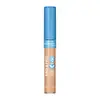What's inside
What's inside
 Key Ingredients
Key Ingredients

 Benefits
Benefits

 Concerns
Concerns

No concerns
 Ingredients Side-by-side
Ingredients Side-by-side

Water
Skin ConditioningDicaprylyl Carbonate
EmollientDicaprylyl Ether
EmollientAluminum Starch Octenylsuccinate
AbsorbentGlycerin
HumectantTrimethylsiloxysilicate
EmollientSodium Chloride
MaskingTri (Polyglyceryl-3/Lauryl) Hydrogenated Trilinoleate
EmulsifyingSilica
AbrasiveStearalkonium Bentonite
Gel FormingCetyl PEG/PPG-10/1 Dimethicone
EmulsifyingMica
Cosmetic ColorantPropylene Carbonate
SolventTocopherol
AntioxidantPanthenol
Skin ConditioningTriethoxycaprylylsilane
Sodium Benzoate
MaskingChlorphenesin
AntimicrobialAloe Barbadensis Leaf Juice
Skin ConditioningMethicone
EmollientPantolactone
HumectantPentaerythrityl Tetra-Di-T-Butyl Hydroxyhydrocinnamate
AntioxidantCI 77891
Cosmetic ColorantIron Oxides
Water, Dicaprylyl Carbonate, Dicaprylyl Ether, Aluminum Starch Octenylsuccinate, Glycerin, Trimethylsiloxysilicate, Sodium Chloride, Tri (Polyglyceryl-3/Lauryl) Hydrogenated Trilinoleate, Silica, Stearalkonium Bentonite, Cetyl PEG/PPG-10/1 Dimethicone, Mica, Propylene Carbonate, Tocopherol, Panthenol, Triethoxycaprylylsilane, Sodium Benzoate, Chlorphenesin, Aloe Barbadensis Leaf Juice, Methicone, Pantolactone, Pentaerythrityl Tetra-Di-T-Butyl Hydroxyhydrocinnamate, CI 77891, Iron Oxides
Water
Skin ConditioningIsononyl Isononanoate
EmollientCoconut Alkanes
EmollientGlycerin
HumectantTriethylhexanoin
MaskingMagnesium Sulfate
Polyglyceryl-4 Diisostearate/Polyhydroxystearate/Sebacate
EmulsifyingDiisostearoyl Polyglyceryl-3 Dimer Dilinoleate
EmollientDisteardimonium Hectorite
StabilisingAloe Barbadensis Leaf Juice
Skin ConditioningStearoyl Inulin
EmollientPropylene Carbonate
SolventEthylhexylglycerin
Skin ConditioningHydrogenated Lecithin
EmulsifyingMagnesium Oxide
AbsorbentAluminum Hydroxide
EmollientAlumina
AbrasivePhenoxyethanol
PreservativePotassium Sorbate
PreservativeSodium Benzoate
MaskingCI 77491
Cosmetic ColorantCI 77492
Cosmetic ColorantCI 77499
Cosmetic ColorantCI 77891
Cosmetic ColorantWater, Isononyl Isononanoate, Coconut Alkanes, Glycerin, Triethylhexanoin, Magnesium Sulfate, Polyglyceryl-4 Diisostearate/Polyhydroxystearate/Sebacate, Diisostearoyl Polyglyceryl-3 Dimer Dilinoleate, Disteardimonium Hectorite, Aloe Barbadensis Leaf Juice, Stearoyl Inulin, Propylene Carbonate, Ethylhexylglycerin, Hydrogenated Lecithin, Magnesium Oxide, Aluminum Hydroxide, Alumina, Phenoxyethanol, Potassium Sorbate, Sodium Benzoate, CI 77491, CI 77492, CI 77499, CI 77891
 Reviews
Reviews

Ingredients Explained
These ingredients are found in both products.
Ingredients higher up in an ingredient list are typically present in a larger amount.
Aloe Barbadensis Leaf Juice comes from leaves of the aloe plant. Aloe Barbadensis Leaf Juice is best known for helping to soothe sunburns. It is also anti-inflammatory, moisturizing, antiseptic, and can help heal wounds.
Aloe is packed with good stuff including Vitamins A, C, and E. These vitamins are antioxidants, which help fight free-radicals and the damage they may cause. Free-radicals are molecules that may damage your skin cells, such as pollution.
Aloe Barbadensis Leaf Juice also contains sugars. These sugars come in the form of monosaccharides and polysaccharides, folic acid, and choline. These sugars are able to help bind moisture to skin.
It also contains minerals such as calcium, 12 anthraquinones, fatty acids, amino acids, and Vitamin B12.
Learn more about Aloe Barbadensis Leaf JuiceCi 77891 is a white pigment from Titanium dioxide. It is naturally found in minerals such as rutile and ilmenite.
It's main function is to add a white color to cosmetics. It can also be mixed with other colors to create different shades.
Ci 77891 is commonly found in sunscreens due to its ability to block UV rays.
Learn more about CI 77891Glycerin is already naturally found in your skin. It helps moisturize and protect your skin.
A study from 2016 found glycerin to be more effective as a humectant than AHAs and hyaluronic acid.
As a humectant, it helps the skin stay hydrated by pulling moisture to your skin. The low molecular weight of glycerin allows it to pull moisture into the deeper layers of your skin.
Hydrated skin improves your skin barrier; Your skin barrier helps protect against irritants and bacteria.
Glycerin has also been found to have antimicrobial and antiviral properties. Due to these properties, glycerin is often used in wound and burn treatments.
In cosmetics, glycerin is usually derived from plants such as soybean or palm. However, it can also be sourced from animals, such as tallow or animal fat.
This ingredient is organic, colorless, odorless, and non-toxic.
Glycerin is the name for this ingredient in American English. British English uses Glycerol/Glycerine.
Learn more about GlycerinThis ingredient is a solvent. It helps dissolve active ingredients and alter the texture of products.
Propylene Carbonate is commonly used in makeup and with clay, such as montmorillonite or bentonite.
Studies show this ingredient to be safe for cosmetics. When it is undiluted, it can cause skin irritation. (It is always diluted in skincare and makeup). This ingredient is water-soluble.
Propylene Carbonate is created from propylene glycol and carbonic acid.
Learn more about Propylene CarbonateSodium Benzoate is a preservative. It's used in both cosmetic and food products to inhibit the growth of mold and bacteria. It is typically produced synthetically.
Both the US FDA and EU Health Committee have approved the use of sodium benzoate. In the US, levels of 0.1% (of the total product) are allowed.
Sodium benzoate works as a preservative by inhibiting the growth of bacteria inside of cells. It prevents the cell from fermenting a type of sugar using an enzyme called phosphofructokinase.
It is the salt of benzoic acid. Foods containing sodium benzoate include soda, salad dressings, condiments, fruit juices, wines, and snack foods.
Studies for using ascorbic acid and sodium benzoate in cosmetics are lacking, especially in skincare routines with multiple steps.
We always recommend speaking with a professional, such as a dermatologist, if you have any concerns.
Learn more about Sodium BenzoateWater. It's the most common cosmetic ingredient of all. You'll usually see it at the top of ingredient lists, meaning that it makes up the largest part of the product.
So why is it so popular? Water most often acts as a solvent - this means that it helps dissolve other ingredients into the formulation.
You'll also recognize water as that liquid we all need to stay alive. If you see this, drink a glass of water. Stay hydrated!
Learn more about Water